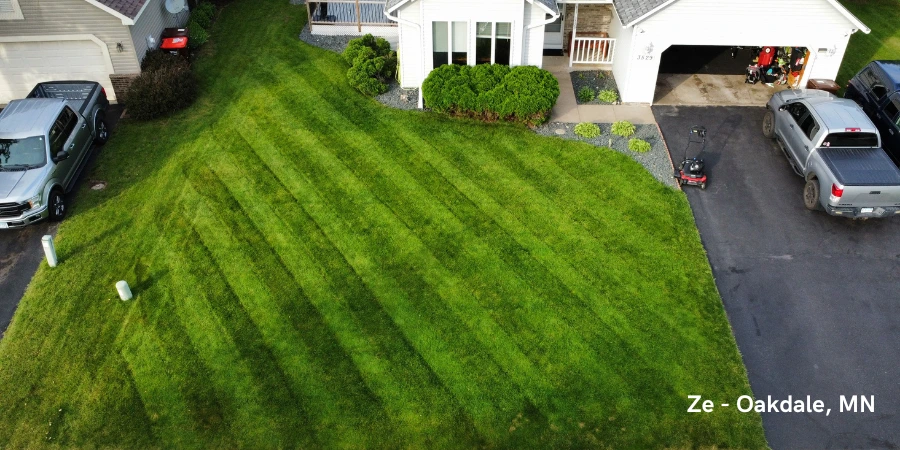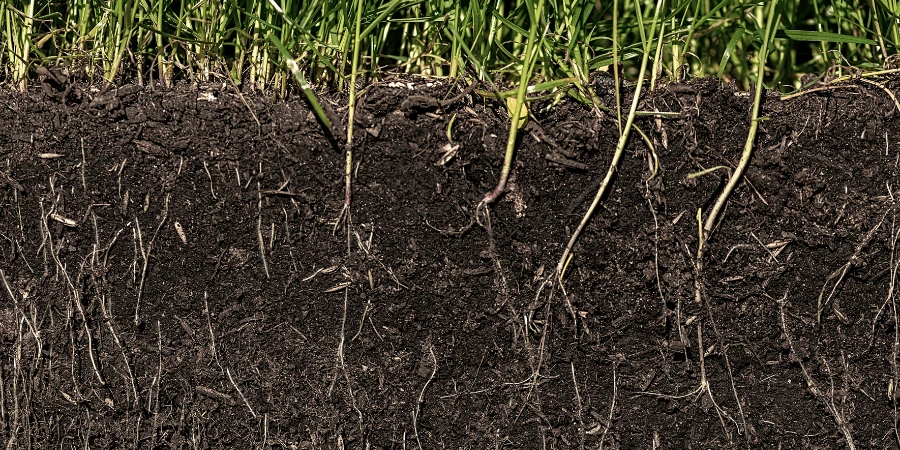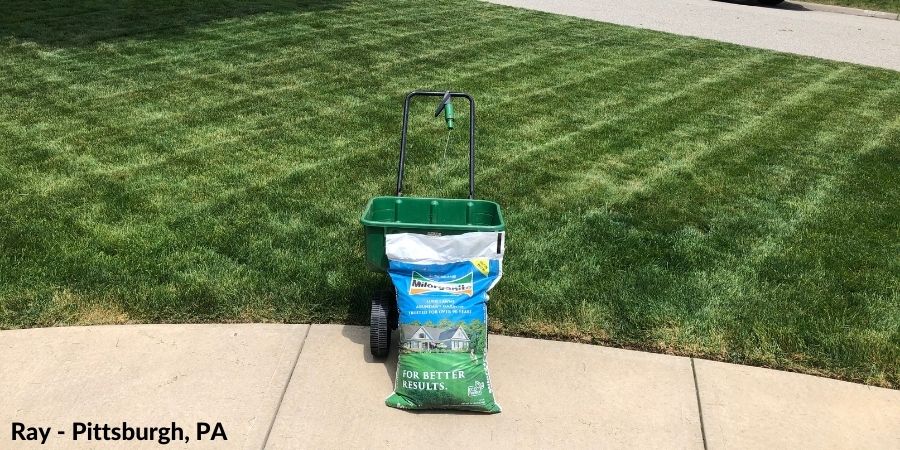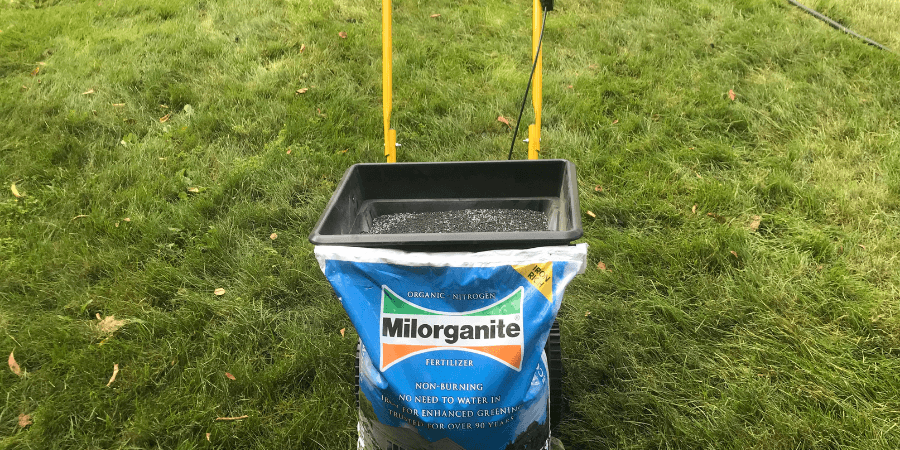Iron in Milorganite: The Key to Healthy, Green Lawn
- Milorganite AgronomistMarch 15, 2025
Iron doesn’t make turfgrass green!
Well, not directly, at least.
Iron is a key micronutrient that helps in the construction of chlorophyll. It’s the chlorophyll that makes plants green. Milorganite contains a form of iron that is water soluble and won’t stain concrete when used as directed. Milorganite is a slow-release fertilizer, so along with the other nutrients, iron is available to plants at a rate they can use it.
Milorganite Contains Nutrients Grass Needs, including Iron
Milorganite contains the three primary nutrients grass needs to grow strong, as well as a number of secondary and micronutrients essential for plant growth. The nutrient analysis of Milorganite is 6-4-0: 6% nitrogen (N), 4% phosphorus (P), and less than one percent potassium in each bag. Milorganite also contains a minimum of 2.5% iron, which is a micronutrient.

How Does Iron Work to Make Lawns Green?
Iron doesn’t directly make turfgrass green; chlorophyll does. Chlorophyll is the green pigment in plants that allow them to photosynthesize. Iron isn’t even part of chlorophyll’s structure but is essential to its construction. Nitrogen deepens the green color of turfgrass.
What Does Iron Do for Lawns?
Iron helps plants produce more chlorophyll. Through photosynthesis, chlorophyll harvests light energy from the sun and converts it to chemical energy plants use as food. More chlorophyll is produced when there is a sufficient amount of iron available to plants, resulting in a greener lawn.
How Do I Know if My Lawn Needs Iron?
Chlorophyll is what makes plants green, and iron is critical to chlorophyll production. Insufficient amounts of available iron reduce chlorophyll production and cause leaf blades to turn yellow or become pale green, referred to as chlorosis.
You may notice a yellow patch or that your lawn is, in general, turning a pale green. These are signs of an iron deficiency in the soil. On close inspection, chlorosis causes young leaf blades to emerge pale green or yellow. The veins will remain green, while the area between the veins turns yellow. If the iron deficiency isn’t treated, new leaf blades will continue to appear lighter and lighter as they emerge.
When is the Best Time to Apply Iron to Your Lawn?
Milorganite contains the iron your lawn needs to keep it as green as possible. Follow the Milorganite seasonal fertilization schedule, and you won’t need to worry about applying iron in a separate application. In fact, applying iron in addition to Milorganite is not recommended. Too much iron can cause other problems.
What is the Source of Milorganite’s Iron?
Iron is added during the wastewater reclamation process to bind and maximize the amount of phosphorus removed. The iron additive remains in the resulting Milorganite.
Chelation is a process of surrounding an insoluble metal, including iron, with an organic complex that stabilizes it to protect it from oxidation and precipitation. This addition makes it water soluble but is expensive to produce. The iron in Milorganite mimics chelated iron, is equally effective, and is more cost-effective to produce.
Iron in Milorganite Doesn’t Stain
There are other sources of iron that are inexpensive to produce, including ferrous or iron sulfate (a salt), the most commonly found soluble iron found in turfgrass fertilizers. Ferrous sulfate oxidizes when it comes into contact with moisture. This can create rust-like stains on cement surfaces. Any non-chelated iron can potentially cause stains, which are extremely difficult to remove and may cause plants to burn.
Milorganite’s iron is water soluble and non-staining when used as directed because it acts like chelated iron.

What’s the Difference Between Iron Added to the Soil Compared to Spraying?
Spraying nutrients directly onto turfgrass is called foliar feeding. Plants absorb nutrients more quickly through pores on the leaf surface rather than through the roots.
Although foliar-feeding plants with iron show quicker results (greens grass more quickly), it will be short-lived compared to applying fertilizer to the soil. The iron can wash off grass blades, and after cutting the lawn a few times, there’s no longer any part of the leaf blade that was covered with iron.
The iron in Milorganite, applied to the soil, is longer lasting and requires fewer applications.
Should I Have My Soil Tested for Iron?
The iron content in soil can vary quickly, so a soil test for iron isn’t the most helpful. Testing for the pH of your soil, on the other hand, is more helpful. The ideal pH for lawns is 6.5 – 7.0, slightly acidic to neutral. Iron is readily available to plants when the pH is within the same range or lower, which is more acidic. High-pH soils are more likely to have iron deficiencies.
Knowing the pH of your soil will also help you determine which nutrients may be unavailable to plants due to the soil’s pH.
Is it Possible to Apply Too Much Iron?
Yes, it’s possible to apply too much iron to your lawn. Like other nutrients plants require, too much can have negative effects. Iron is a micronutrient. Only small amounts are needed for a healthy lawn.
Excessive iron causes grass to appear dark, even black, results in stunted growth, and may lead to nutrient imbalances in the soil. If there are signs of over-fertilizing with iron, thoroughly water the lawn to dilute the iron concentration. But this can cause another problem: nutrient runoff.
So, it’s best to only apply the amount of nutrients your plants need. Anything more can be harmful to plants, soil, and the environment. Always remember to sweep any excess Milorganite back into your lawn or garden to help keep it out of our waterways.
The nutrients in Milorganite, including iron, are released slowly, at a rate the plant can use. This makes iron available to grass for longer, and you don’t have to fertilize as often. It minimizes the risk of nutrient runoff.



